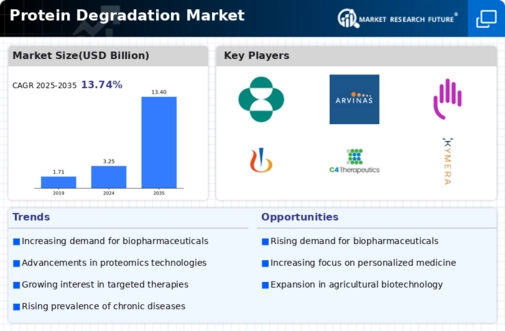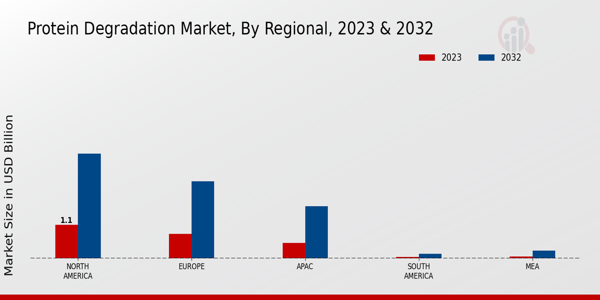Market Trends and Projections
Rising Demand for Biopharmaceuticals
The Global Protein Degradation Market Industry experiences a notable surge in demand for biopharmaceuticals, driven by advancements in therapeutic proteins and monoclonal antibodies. As the biopharmaceutical sector expands, the need for effective protein degradation technologies becomes increasingly critical. In 2024, the market is projected to reach 3.25 USD Billion, reflecting the growing reliance on protein-based therapies. This trend is expected to continue, with the market anticipated to grow to 13.4 USD Billion by 2035, indicating a compound annual growth rate (CAGR) of 13.75% from 2025 to 2035. Such growth underscores the importance of innovative protein degradation solutions in meeting therapeutic needs.
Increasing Prevalence of Chronic Diseases
The Global Protein Degradation Market Industry is significantly impacted by the increasing prevalence of chronic diseases, such as cancer and neurodegenerative disorders. These conditions often involve protein misfolding and aggregation, necessitating effective protein degradation therapies. The growing patient population drives demand for innovative treatment options, thereby propelling market growth. As healthcare systems worldwide prioritize the development of targeted therapies, the market is expected to expand from 3.25 USD Billion in 2024 to 13.4 USD Billion by 2035. This growth trajectory, characterized by a CAGR of 13.75% from 2025 to 2035, underscores the critical role of protein degradation technologies in addressing chronic health challenges.
Growing Investment in Biotechnology Research
The Global Protein Degradation Market Industry benefits from the increasing investment in biotechnology research. Governments and private sectors are allocating substantial resources to explore innovative solutions for protein degradation, recognizing its potential in therapeutic applications. This influx of funding accelerates research initiatives, leading to breakthroughs in protein degradation technologies. As the market evolves, it is anticipated to expand from 3.25 USD Billion in 2024 to 13.4 USD Billion by 2035, with a CAGR of 13.75% from 2025 to 2035. Such investment not only enhances the development of new therapies but also strengthens the overall biotechnology landscape.
Technological Advancements in Protein Engineering
Technological innovations in protein engineering significantly influence the Global Protein Degradation Market Industry. Advances in synthetic biology and CRISPR technology enable the development of novel protein degradation strategies, enhancing the efficacy of therapeutic proteins. These innovations facilitate targeted degradation of misfolded or damaged proteins, which is crucial for treating various diseases. As the industry embraces these technologies, the market is poised for substantial growth, with projections indicating a rise from 3.25 USD Billion in 2024 to 13.4 USD Billion by 2035. This trajectory suggests a robust CAGR of 13.75% for the period from 2025 to 2035, highlighting the transformative potential of protein engineering.
Regulatory Support for Biopharmaceutical Innovations
Regulatory bodies globally are increasingly supportive of biopharmaceutical innovations, which positively influences the Global Protein Degradation Market Industry. Initiatives aimed at expediting the approval process for new therapies encourage investment in protein degradation technologies. This regulatory environment fosters research and development, enabling companies to bring novel solutions to market more efficiently. As a result, the market is projected to grow from 3.25 USD Billion in 2024 to 13.4 USD Billion by 2035, reflecting a CAGR of 13.75% from 2025 to 2035. This supportive framework is essential for driving advancements in protein degradation, ultimately benefiting patient outcomes.






















